Easy Fish for a 55 Gallon Fish Tank
55-gallon fish tanks are a great choice for someone who wants to get creative, as there is plenty of space to fit in some larger fish.
Maybe you want some large freshwater Cichlids, or perhaps a selection of colorful marine fish.
You can set up the tank however you like.
Anyone can care for this tank. Its large size makes it easier to keep the water clean, so beginners will find it easier than they would with smaller tanks.
Advertisements
We will walk you through everything you need to know about starting a new 55-gallon tank, from how to set it up to stocking suggestions, and much more…
All About The 55 Gallon Fish Tank

A 55-gallon aquarium provides far more stocking options when compared to smaller aquariums, like 10 gallon tanks.
You could choose freshwater fish, saltwater fish, or even get creative with something like a paludarium.
Large tanks like this are easier to maintain since the more water you have, the harder it is for pollutants to build up. They take longer to clean though – so you will need to set extra time aside for wiping the larger glass walls and performing bigger water changes.
This is not difficult however, even beginners will be able to maintain a healthy tank if they pick some hardy fish. More experienced aquarists will enjoy filling the tank with some temperamental species, like aggressive Cichlids.
As you might have guessed, big tanks cost more. Expect to pay $200 or more for a new 55 gallon one. This number will rise if you have to buy your equipment separately.
It will weigh more too. Once filled with just water, it will weigh around 600lb. The weight will increase even more once you add the decorations and fish.
55 Gallon Fish Tank Equipment
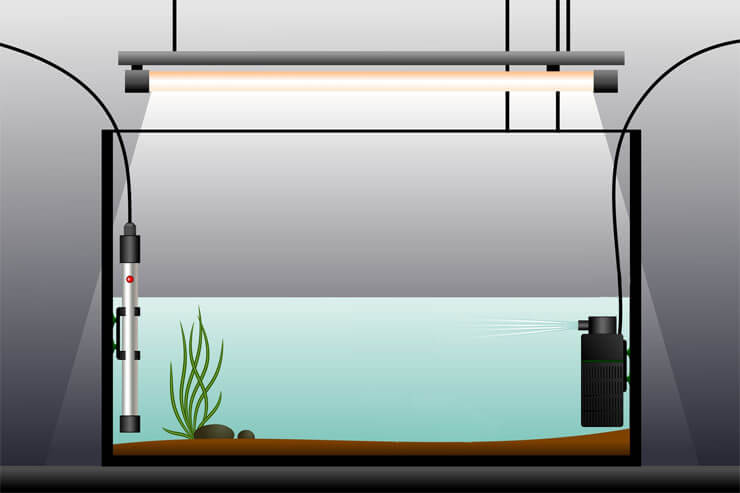
Filter
This is the most crucial part of any aquarium. A filter is responsible for cleaning the tank's water. This includes both mechanical filtration (removing debris) and biological filtration (using bacteria to convert harmful chemicals).
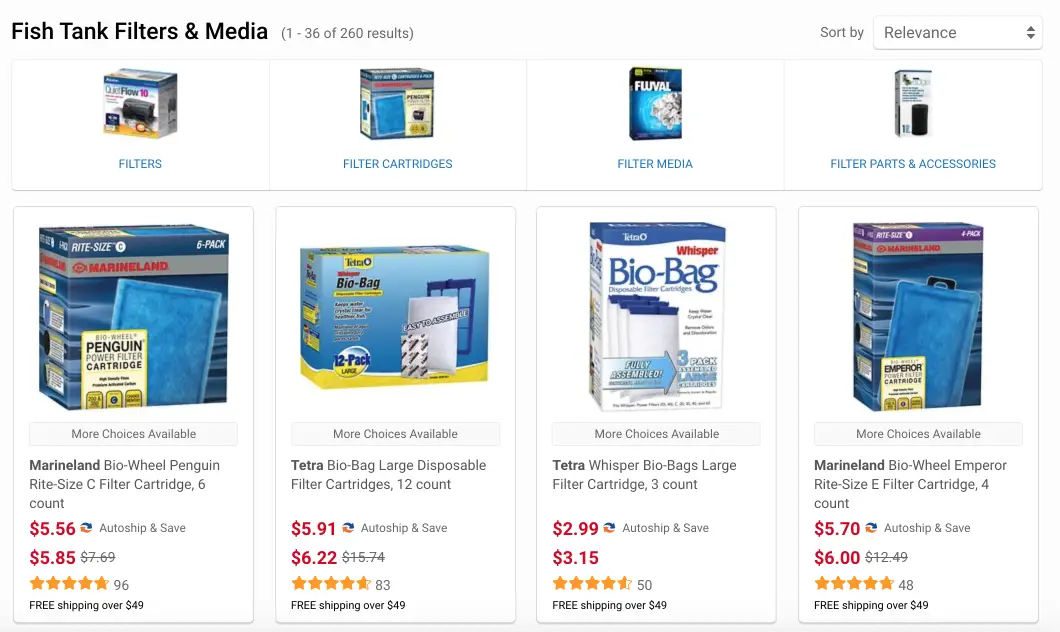
A tank without a filter will quickly become toxic for your fish as pollutants build up in the water.
There are many kinds of filters to meet different needs. These include canister filters, HOB filters, sponge filters, and undergravel filters.
Your new tank will likely come with a filter. You need to make sure that you don't overload your tank with fish so that the filter can cope with the amount of waste being produced.
Advertisements
Heater
This is another important piece of equipment. Heaters are used in most freshwater or saltwater aquariums. Exceptions include cold water tanks or areas where the surrounding temperatures are warm enough.
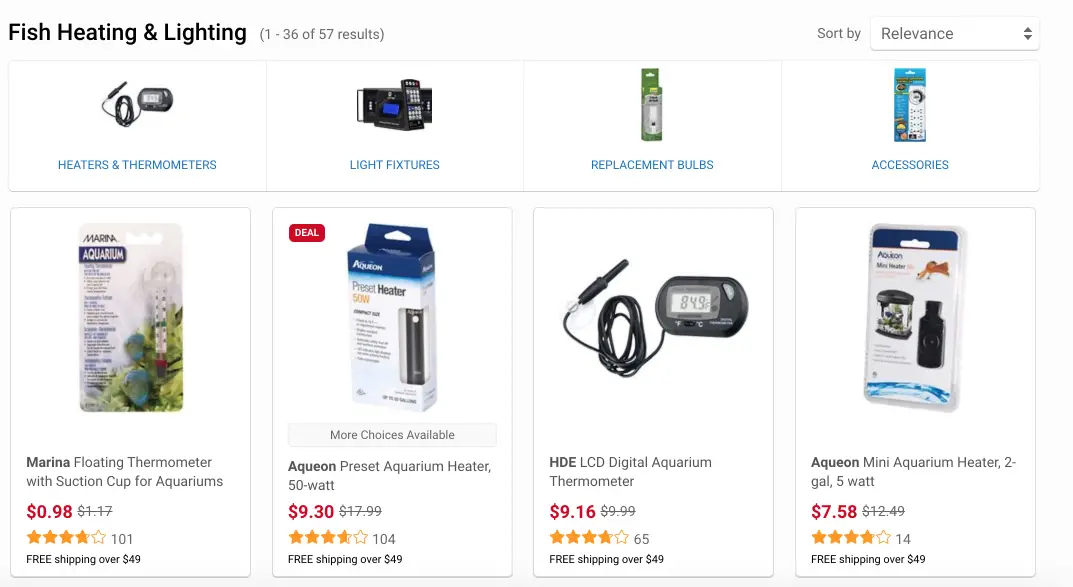
When buying a heater, the packaging should clearly indicate if it is suitable for a 55-gallon aquarium.
The temperature is set to meet the needs of your fish. When planning a community fish tank, the preferred temperature ranges of each species need to overlap.
Advertisements
Heaters are easy to install, they just sit on the wall of your aquarium, usually using suction cups.
Lights
A tank's lighting setup is more important than you might think. In the wild, different species of fish will come from areas of varying light.
Therefore, you should compare the lighting preferences of each species in your tank (just like you would with the temperature).
Lighting is even more important if you plan on keeping live plants. They require light for photosynthesis, but they may need certain wavelengths or intensities. Corals need light for similar reasons.
Standard aquarium lighting is usually fine for most species. The bulbs are usually part of the hood and can be changed if they are unsuitable or expired.
Other Equipment
There are many additional pieces of electrical equipment, such as pumps, UV sterilizers, and automatic fish feeders. These are not necessities, but they can help you solve certain problems.
You will also likely need the equipment below for your fish tank too:
- A tight-fitting lid is a handy feature that is found on most tanks. You never know when a fish might try to jump out of the water.
- Some people choose to buy a stand for their aquarium. Many models have a stand designed specifically for it, so you can be sure that it can support the tank's weight when full.
- You will need some equipment for cleaning your tank. A gravel vacuum removes waste from the substrate, nets are used to remove dead fish and simple pads or scrubs wipe algae from the aquarium walls.
- Substrates and decorations are common sights in an aquarium. You can choose these based on how you want the tank to look, but you need to consider the needs of your fish too.
What Fish Can You Keep in a 55 Gallon Tank (Stocking Ideas)
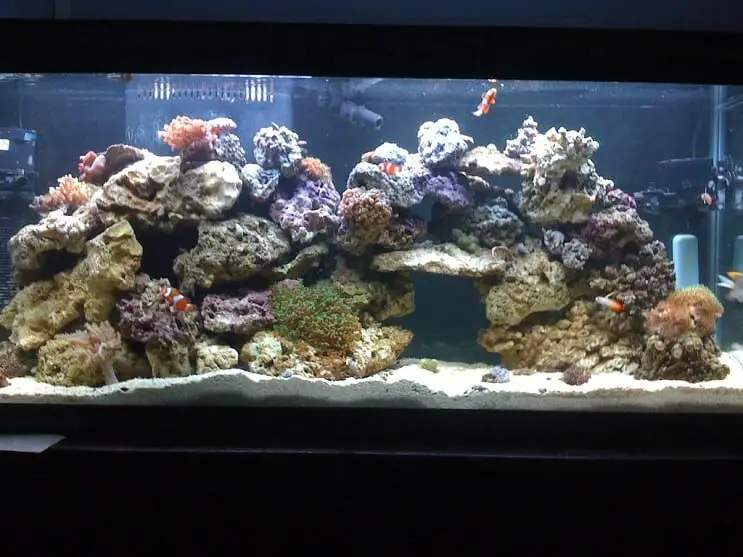
Advertisements
A 55-gallon tank offers plenty of freedom when choosing fish. There is enough space to fit some larger species, whereas smaller tanks restrict you to little ones.
The first question when choosing fish is: what type of tank do you want? Both freshwater and saltwater aquariums are valid options, each offering a different selection of fish.
Starting with freshwater fish, Cichlids are a great option. Most are colorful and exotic, like Peacock and Cockatoo Cichlids. However, many people are put off by the aggressive and territorial behaviors that are often associated with Cichlids. Oscars and Convict Cichlids are a couple of infamous examples.
Gouramis are a popular alternative. They are much less aggressive and many varieties, like Pearl Gouramis, also display some lovely colors and patterns.
Another option is to create larger shoals of some smaller species. A group moving together can be a truly impressive sight. Guppies, Neon Tetras, and Zebra Danios all work well.
Plenty of saltwater favorites will easily fit in your 55-gallon fish tank. These include Blue Tangs, Clownfish, and the vibrant Mandarinfish.
Damselfish, Coral Beauties, and Butterflyfish are some other, colorful saltwater options. Diamond Watchmen Gobies and Blennies will occupy the bottom areas of the tank, clearing up excess food sitting on the substrate.
Fish are not the only animals that can go in a 55-gallon tank, invertebrates make great pets too. Shrimp and snails are the most common options. There are many species, such as Ghost Shrimp or Nerite Snails.
You can also add plants into the mix, or even make a paludarium. Plants are a great way to raise oxygen levels and provide another form of shelter.
Some plants are easier to care for than others. Beginners may be best off with hardy Hornwort or Dwarf Hairgrass. More experienced aquarists might prefer trying Rotala Green or Cyperus helferi.
Advertisements
55 Gallon Tank Setup Ideas
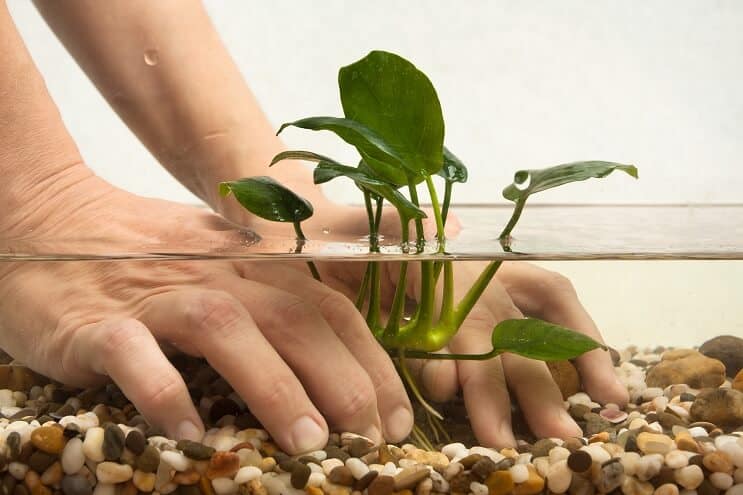
There are two main types of tank: freshwater and saltwater.
No two tanks look the same though, since you are able to design your tank to meet your own personal preference. Freshwater tanks are perhaps the most varied. There are lots of decorations available in pet stores, some are comical and others fit a certain theme. The possibilities are endless.
A popular option is to produce a natural-looking aquarium, filled with live plants, rocks, and bogwood.
Saltwater tanks are a little less varied. Most will contain an assortment of corals because they are the natural home of most marine fish.
Advertisements
Corals can be swapped out for decorations and plants if they are out of your price range. It's important to note that saltwater aquariums in general are more expensive.
A tank can always be used as a paludarium if you only want to care for plants. Or maybe you want to try some more exotic animals, like crabs.
Buying Your Fish Tank
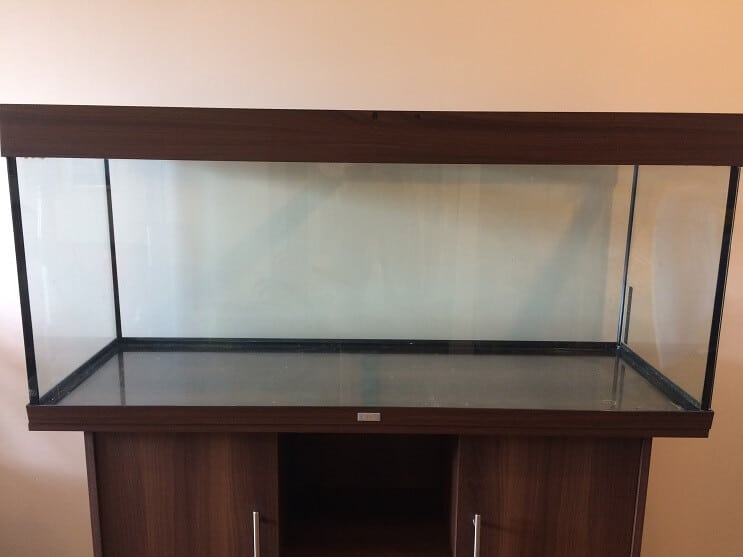
One thing that most people don't consider when buying a tank is what it's made of. Most are made from glass, but some stores offer acrylic alternatives.
Glass is considered the higher quality option, as acrylic is easier to scratch.
Advertisements
Acrylic can lose its clarity over time too. This is most noticeable in direct sunlight, as a yellow tinge may gradually appear. Glass is the best long-term investment as you will probably never have to replace it.
So far, it does not seem as though acrylic has any advantages. The main reason that you might want it, is because it's lighter. If you are unsure about the strength of your stand, acrylic is the safest option.
You might also want to consider the shape of the aquarium. 55-gallon fish tanks are not always rectangular. For example, some are designed to fit in the corner of a room. If you have restricted space at home, try searching for more effective aquarium shapes.
Once you have chosen the one you want, check it for visible signs of damage to prevent issues later on when setting it up.
How to Setup a 55 Gallon Fish Tank
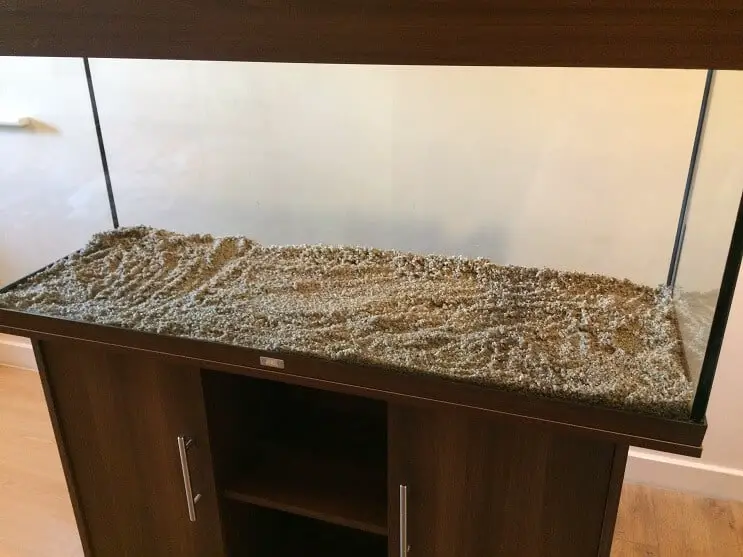
Setting up the Tank
To set up a new 55 gallon tank, you usually start at the bottom and work your way up. This means the first thing to do is add the substrate.
Gravels and sands are filled with dust particles, so you need to rinse them first. Run water through the substrate while agitating it with your hand, do this until the water runs clear. Add a layer to the bottom of the tank, aiming for it to be 0.5-1 inch thick. Now you can place your decorations on the substrate, rinsing them first.
The next step is to pour in some water. Before doing this, make sure that you are happy with the placement of the aquarium.
Treat the tap water with dechlorinator to remove the harmful chlorine. The bottle should indicate how much you should be adding.
A marine tank will need artificial saltwater. This is done by combining purified water and sea salt, to produce the salinity that you need. The salt might take a while to dissolve so leave the water for a day.
Advertisements
Lastly, you can add the equipment. Each piece should come with instructions describing how to install that particular model. Rinse each device and the internal media of the filter before adding them.
Cycling the Tank
Toxic ammonia is released into the water via fish waste. This is broken down into less harmful substances by bacteria, so you need to culture bacterial populations before adding fish. This is known as cycling the tank.
The cycle follows the nitrogen cycle. One group of bacteria converts ammonia to nitrite, and then another group converts nitrite to nitrate. Nitrate isn't toxic in low quantities, whereas the other two compounds are.
Cycling can take 2-8 weeks to cycle a 55-gallon aquarium, but most of the process is automated. Add an initial 2-4ppm of ammonia, and then add an additional 1ppm every few days.
Use a water testing kit every week to check the ammonia, nitrite, and nitrate levels of the water. After two weeks, nitrite levels should spike. Once ammonia and nitrite levels reach 0ppm, the cycle is over.
Advertisements
You can now slowly introduce fish to the aquarium.
The process we have described is fishless cycling. Cycling with fish is considered unethical since you are actively exposing the fish to harmful conditions.
Adding Fish
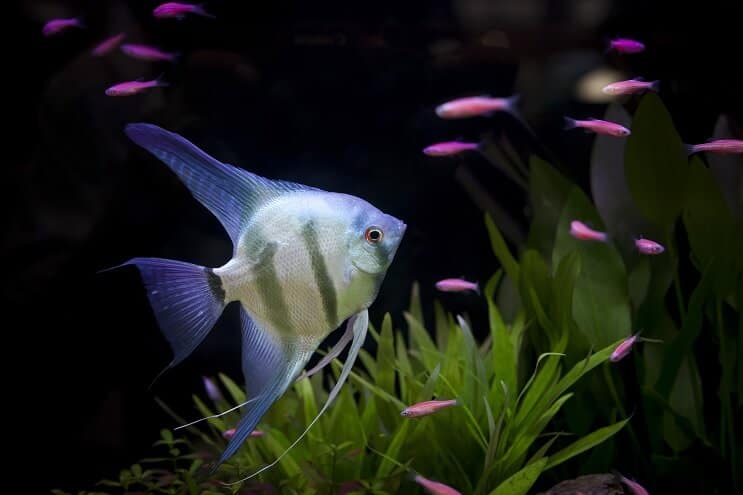
Don't add too many fish at once or you risk kick-starting the cycle again (since there will be too much waste for the bacteria to handle.
To add fish you first need to turn off the aquarium light and let the plastic bag float on the water's surface for 15 minutes, to acclimate the fish to the new temperature.
Advertisements
Open the bag and add half a cup of your tank's water every 15 minutes for one hour. This will acclimate the fish to the new water parameters.
Use a net to remove the fish from the bag and release them into their new home.
Don't let any water from the bag enter your aquarium, to avoid introducing pollutants or diseases. Leave the light off for a few hours. The moving process is stressful for your fish, dark conditions will help them to relax and get used to their new environment.
How to Maintain a 55 Gallon Fish Tank
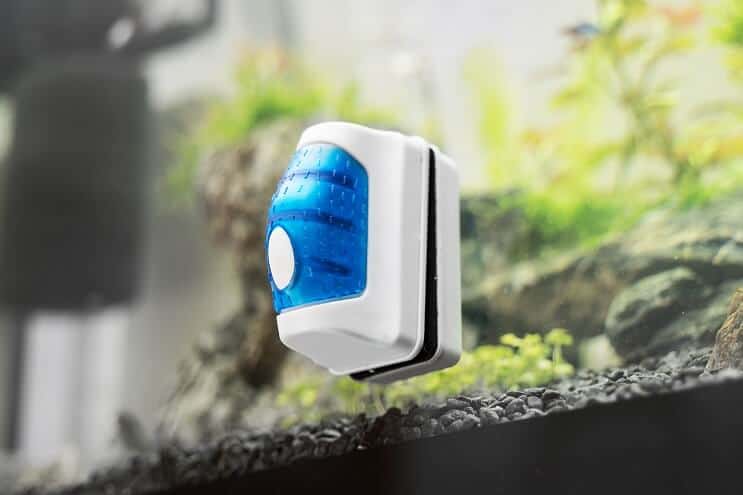
Water changes need to be performed every 1-2 weeks to maintain a healthy aquarium. Luckily, they don't take much time.
Advertisements
Use an aquarium vacuum to siphon roughly 30% (16-17 gallons) of the water into a bucket. Use this water to rinse and clean the equipment in your tank, then get rid of it.
Never use tap water for cleaning or you will kill the beneficial bacteria in the tank.
Replace the water with fresh tap water that has been treated with dechlorinator. It needs to be a similar temperature to the aquarium water, as a sudden temperature change can cause stress and disease.
If you see algae starting to grow on walls or decorations, scrape it off with a pad. This will just take a few minutes every couple of days. If the algae are left to keep growing, it will soon get out of hand.
Any equipment that you use for cleaning the tank must be solely used for fishkeeping.
Cloudy Water
New setups are prone to cloudy water as it's easy to trigger a mini-cycle. This may happen if some common mistakes are made, like an excessive water change or the introduction of too many fish at once.
In this situation, the cloud is a sudden bloom of bacteria. It should pass on its own within two weeks.
Alternatively, the cloud could be dust in the water. This is just a matter of substrates and decorations not having been rinsed thoroughly before being added. The cloud will gradually reduce over time.
Algae can cause cloudy water too, indicated by a slightly green coloration. You can remove the algae by performing extra water changes and keeping direct sunlight away.
Summary
Going for the biggest tank you can afford is usually the right choice. If you are new to fishkeeping, 55 gallons might seem intimidating but it will be easier to care for than smaller tanks.
Advertisements
The process of setting it up is pretty much the same as any other tank, except you have more freedom to choose what you want to keep inside.
Your fish will have plenty of swimming space, which will keep them happier. If the tank is regularly cleaned, it will thrive.
Whether it is a species only or community, freshwater or saltwater, a 55-gallon fish tank will make a great attraction for your home.
Which size tank do you have? Let us know in the comments section below…
Source: https://www.fishkeepingworld.com/55-gallon-fish-tank/
Enregistrer un commentaire for "Easy Fish for a 55 Gallon Fish Tank"